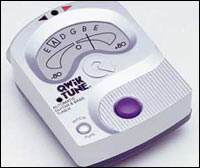Tuning your
Banjo Tuning your banjo can be a difficult task for you if
you are just beginning to learn how to play the banjo. It
might be a little tricky for you with the 5th string being
halfway down the fret board. The good news is, the more you
do it, the easier it becomes. A nicely tuned banjo can make
your music sound a lot better. Here we show you many methods
on how to tune a banjo, and also our free online banjo tuner.

You can use a keyboard
or piano to tune each individual string to a specific note
on the piano. An easy and quick way for beginners.

Tuning with an Electronic
tuner is an easy task. Just twang your string and turn the
pegs until it matches with the corresponding note.
If you do not have a
tuner just yet.. you can tune your Banjo right here online.
Tuner
provided by Get
Tuned
Tuning
Tips
Keep in mind that the
tuning above is "G tuning," which is the most common
tuning for the banjo. Some other common banjo tunings are
listed below.
Notice that the notes the open strings are to be tuned to
are written on the left side of the first line of tablature.
For G tuning these are:
D - 1st string
B - 2nd string
G - 3rd string (one octave lower than the 5th string)
D - 4th string (one octave lower and the 1st string)
G - 5th string (the short string on top when holding the banjo)
Learning to tune the banjo properly is a skill that must be
developed as you train yourself what sounds right and what
doesn't. Just as your playing will improve over time with
continued practice, your ability to tune the banjo will develop
over a long period of time as you develop an ear for the proper
sounds.
Always listen to the note you are going tune along with first,
and then pluck your string and match up the sound.
When tuning a string, be sure to pluck the string with your
right hand as you turn the tuning peg so you can hear the
sound. Be sure to continually sound the string to ensure you
are not tuning it too high, thus possibly breaking the string.
If you can't tell whether the pitch of the string is too high
or too low, tune the string down to a point you know is LOWER
than the correct pitch, and then tune up until you reach the
right pitch.
Other Common Tunings
The banjo is usually
tuned in an open tuning, which enables you to play more open
strings and less difficult chords with the left hand. There
are dozens of different tunings that have been used over the
years, but listed below are some of the more popular tunings
that are used. If you have an electronic tuner you should
have no difficulty in using these tunings when they are called
for.
G Modal Tuning -- This
is a very popular tuning for old-time tunes such as Shady
Grove, Little Sadie, and many others. It is also sometimes
called “sawmill tuning” or “mountain minor
tuning.” From G tuning only the 2nd string is retuned.
D
C - From G tuning, tune the B note up to C.
G
D
G
Double C Tuning -- This
tuning is very popular among clawhammer banjo players and
is probably even more popular than G tuning for playing fiddle
tunes. Many fiddle tunes are played in the key of D by fiddlers
and banjo players will play along using this tuning and put
a capo on the 2nd fret to get in the key of D. Notice that
from G Modal tuning only one string is retuned.
D
C - From G tuning, tune the B note up to C.
G
C - From G tuning, tune the D note down to C.
G
Standard C Tuning --
This was the first tuning that Pete Seeger taught in his classic
book, “How to Play the 5-string Banjo.” It is
not really an open tuning but allows you to easily form the
most used chords in the key of C (C, F, and G). This was the
standard tuning for the 4-string plectrum banjo. It is not
the most popular tuning but can come in handy for playing
in the key of C and is quickly accessible from G tuning.
D
B
G
C - From G tuning, tune the D note down to C.
G
D Tuning -- D tuning
is probably the most common alternative tuning for bluegrass
players. The 5th string can either be tuned to A or F#, depending
on which sounds best for different songs.
D
A - From G tuning, tune the B note down to A.
F# - From G tuning, tune the G note down to F#.
D
A or F# - From G tuning, tune the G note up to A or down to
F#.